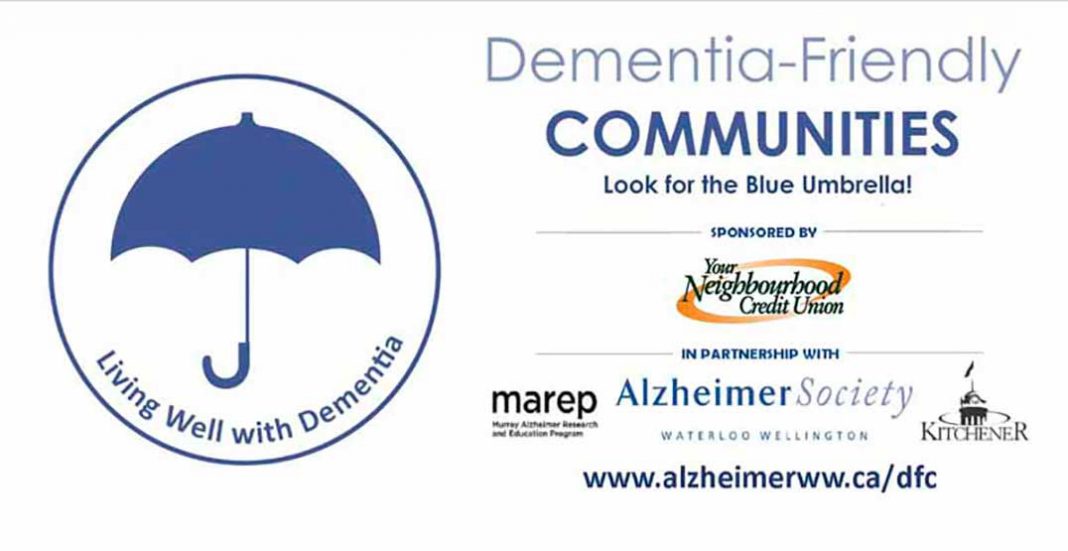Program seeks to help communities provide support for residents living from dementia
SUDBURY—There are many challenges presented by an aging society and few are more daunting than those dealing with the rise of incidents of dementia, such as Alzheimer’s, in the general public. While we have all heard plenty of comedy routines and jokes based on the loss of memory and cognitive abilities, dementia is no laughing matter to those afflicted or to the people who care for them. The Alzheimer’s Society’s Blue Umbrella Program is seeking to help communities to provide support for those suffering from dementia.
Piloted in Bobcaygeon, the Blue Umbrella Program grew out of the concept of the dementia-friendly community, which itself was developed in Japan as a response to a rapidly aging population.
According to the Alzheimer’s Society, dementia-friendly communities “help people with dementia feel included and supported in the places they work, live and play. Dementia-friendly communities began in Japan as a way to support the increasing numbers of people living with dementia as a result of an aging population. From there, the initiative spread to the United Kingdom.”
The program successfully rolled out in Thunder Bay and North Bay in 2016 and was introduced to Sudbury in the latter part of the year.
“The official name of the program is ‘Living Well With Dementia Blue Umbrella Program’,” said Jessica Bertuzzi-Gallo, public relations/community development representative with the Alzheimer Society Sudbury-Manitoulin North Bay and Districts. Ms. Bertuzzi-Gallo noted that since the program’s launch in Sudbury the response has been brisk. “We have been getting a lot of interest,” she said. “It is picking up steam big time.”
Ms. Bertuzzi-Gallo noted that a dementia-friendly community focuses on stigma reduction and the inclusion of people with dementia. “People are educated about dementia and know that a person with dementia may sometimes experience the world differently,” she said. “In a dementia-friendly community, people living with dementia feel supported by their community members whether they are at post offices, retail outlets, using transportation or enjoying hobbies out in the community.”
The term “community,” she points out, can mean a location like a neighbourhood or city, “but can also include groups of people with shared interests or features, such as professional groups, religious organizations or businesses.” What this means is that while your municipality can become a Dementia-Friendly Community, so can your book club, faith group or business, such as a local coffee shop or grocery store. In fact, one of the key elements of the Blue Umbrella program is that the Alzheimer’s Society will book a short 30-minute training seminar with your group or business to learn how to engage with dementia suffers (and their caregivers).
“The seminars teach how to communicate and best serve persons with dementia and their caregivers,” explained Ms. Bertuzzi-Gallo. This allows people to feel comfortable going out in the community without experiencing stigma.
An example might be if a dementia sufferer is standing in line at the bank. One of the bank employees might take the client off to a quieter part of the office to assist them with their business. Simple things like eye-contact and understanding how dementia can impact a person’s cognitive functions can help reduce stress on both sides of the counter.
According to Ms. Bertuzzi-Gallo, dementia-friendly communities “are defined by both their social and physical characteristics. These attributes can help support people with dementia by reducing anxiety, stigma or frustration.”
So in dementia-friendly communities, people come to realize that those with dementia are more than their diagnosis.
Dementia can affect a person’s cognition, behaviour, emotions and physical capabilities, and everyone can play a role in recognizing people with dementia as a part of the community and support their independence, value and inclusion.
When it comes to dementia-friendly physical environments, providing a physical environment that is welcoming to people with dementia includes: clear and legible signage placed at eye level; flat, wide and unobstructed sidewalks; and clearly marked accessible washrooms in public spaces and landmarks; distinctive structures; open spaces and places of activity and rest.
After successfully completing Dementia-Friendly Communities training, the business or organization are usually given the opportunity to be included on the Alzheimer Society’s website and newsletter. They are also given a Blue Umbrella decal to place in their window so that people can recognize them as a dementia-friendly haven.
A secret shopper visit one to three months after the education session will provide feedback on how well the organization is doing, and follow ups come at three to six months, six to 12 months and 12-18 months.
While the Blue Umbrella Program will not officially rollout on Manitoulin until sometime this summer, the Alzheimer’s Society will consider coming out to train local businesses on Manitoulin, schedules permitting. Ms. Bertuzzi-Gallo can be reached at the Sudbury office 705-524-2024, extension 232 (800-407-6369) or by email at JBertuzzi-Gallo@alzheimersudbury.ca.



